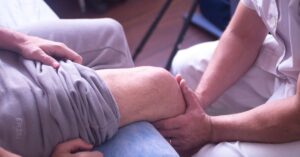Overview of ACL injuries
ACL, or anterior cruciate ligament, injuries are common, particularly among athletes who engage in high-impact sports such as football, basketball, and soccer. The ACL is a major ligament in the knee that helps provide stability and support during physical activity. When this ligament gets overstretched or ruptured, it can significantly impair an individual’s ability to perform daily activities or participate in sports. ACL injuries often result from sudden changes in direction, pivoting motions, or direct trauma to the knee. This overview will briefly explain ACL injuries, including their causes, symptoms, diagnosis, and treatment options. It will also highlight the importance of early intervention and proper rehabilitation in reducing long-term complications.
Definition of ACL injury
An ACL (anterior cruciate ligament) injury refers to a tear or sprain in the ACL, a major ligament in the knee joint. The ACL is crucial in stabilising the knee and stabilising the excessive forward movement of the tibia (shinbone) about the femur (thighbone).
Several factors can lead to an ACL injury, including sudden stops or changes in direction, pivoting with a planted foot, direct blows to the knee, landing awkwardly from a jump, or overextending the knee joint. Soccer, basketball, skiing, and football often feature movements that increase the risk of an ACL injury.
Symptoms of an ACL injury typically include immediate pain and swelling in the knee, a feeling of instability or giving way, and difficulty in bearing weight or walking. Many individuals also report a popping sound or sensation in the knee at the time of injury. In the long term, an untreated ACL injury can result in recurring episodes of instability and can lead to osteoarthritis and other joint problems.
The physical well-being of an individual with an ACL injury is significantly impacted. The person may experience limitations in their ability to participate in physical activities, leading to decreased overall fitness and potential weight gain. In some cases, individuals may also experience emotional distress due to the loss of sports participation or difficulty performing daily activities. Prompt medical evaluation and appropriate treatment, such as physiotherapy and or advanced rehabilitation, are vital to restore knee function and minimise the long-term impairment of physical well-being.
Explanation of what an ACL injury is
An ACL (anterior cruciate ligament) injury is a common type of knee injury that occurs when the ACL, one of the major ligaments in the knee, gets damaged or torn. The ACL stabilises the knee joint and stabilises support to prevent it from excessive forward movement.
Symptoms of an ACL injury may include a loud popping sound at the time of injury, severe pain and swelling, difficulty bearing weight on the affected leg, instability or a feeling of the knee giving way, and a limited range of motion. An ACL injury significantly impacts physical well-being, making walking, running, and performing other activities requiring knee movement difficult. It can also result in muscle weakness, joint stiffness, and a decreased quality of life due to limited physical activity.
An ACL injury commonly occurs during sudden cutting or changing direction, such as basketball, soccer, and football. It can also happen during deceleration when a person slows down abruptly or tries to stop suddenly. Landing from a jump can also cause an ACL injury, especially if done with poor technique or landing straight-legged, as it puts excessive strain on the ligament. Pivoting, where the foot is planted and the body rotates, can also lead to ACL injuries if the knee is twisted or forced to move in an unnatural position.
Common causes of ACL injuries
ACL (anterior cruciate ligament) injuries are common in athletic activities, particularly those involving high intensity and sudden changes in direction. Several factors contribute to ACL injuries, including accidents and gender differences.
Accidents are one of the major causes of ACL injuries. Often, these injuries occur during high-intensity sports such as football, basketball, soccer, and skiing. The high force exerted on the knee joint during rapid movements, pivoting, and jumps can lead to ACL tears. Athletes who engage in these activities are at a higher risk of ACL injuries due to the repetitive stresses on their knees.
Gender differences also play a role in ACL injuries. Studies have shown that female athletes are at a higher risk compared to their male counterparts. This is attributed to anatomy, hormonal differences, and neuromuscular control variations. Female athletes tend to have a narrower intercondylar notch, increased joint laxity, and increased Q-angle, all of which can contribute to ACL tears.
Additional risk factors for ACL injuries include previous ACL tears, inadequate warm-up or conditioning, improper footwear, and playing on hard surfaces. Lack of proper training techniques, such as incorrect landing and cutting mechanics, can also increase the risk of ACL injuries.
Prevention of ACL Injuries
Prevention strategies and exercises are crucial in reducing the risk of ACL (anterior cruciate ligament) injuries. Year-round training and conditioning are essential to maintain overall fitness and strength. This should include cardiovascular exercises, strength training, flexibility training, and agility drills. By keeping the body in peak physical condition, athletes can better withstand the demands on their knees during sports activities.
Proper warm-up and cool-down routines are essential to prepare the body for exercise and prevent injury. A warm-up should involve dynamic stretches, such as leg swings, walking lunges, and high knees, to increase blood flow and strengthen muscles. On the other hand, a cool-down should include static stretches to improve flexibility and reduce muscle soreness.
Landing skills are crucial in reducing the risk of ACL injury, especially for athletes in sports involving jumping or sudden direction changes. Proper techniques, such as landing with knees bent, can help absorb impact and reduce stress on the ACL. Agility exercises, such as ladder and cone drills, improve footwork and body control, reducing the risk of ACL injuries.
Muscle strength training, mainly targeting the quadriceps and hamstrings, helps stabilise the knee joint and stabilise the risk of ACL injuries. Exercises such as squats, lunges, hamstring curls, and leg presses are beneficial for strengthening these muscles.
Importance of injury prevention programs
Injury prevention programs play a crucial role in reducing the risk of ACL injuries, which are among the most common and debilitating injuries in sports and physical activities. These programs aim to improve the musculoskeletal system’s strength, stability, and coordination, particularly in the lower limbs, to minimise the strain on the body and prevent its rupture.
Strength training is a critical component of injury prevention programs. It helps to strengthen the muscles surrounding the knee joint, including the quadriceps, hamstrings, and glutes. Building these muscles can better support the knee and absorb forces that would otherwise be transferred to the ACL.
Balance training is another vital aspect of these programs, as it helps to improve proprioception and stability. By practising exercises that challenge balance, individuals can better control their movements and reduce the risk of sudden, uncontrolled movements that could lead to ACL injuries.
Neuromuscular training is also incorporated into injury prevention programs. It focuses on improving the coordination and timing of muscle activation. By training the muscles to work together in a coordinated manner, less strain is placed on the ACL during dynamic movements.
Functional training, which involves simulating movements specific to an individual’s sport or activity, is also an integral part of these programs. By strengthening the muscles and improving the neuromuscular control during these particular movements, individuals are better equipped to perform them safely and with less strain on the ACL.
Critical components of prevention programs include evaluating neuromuscular control and biomechanics to identify deficiencies or imbalances that can increase the risk of ACL injuries. These evaluations help tailor the program to the individual’s specific needs. Injury prevention programs’ recommended frequency and duration vary, but typically involve at least two to three weekly sessions lasting approximately 30 to 45 minutes.
Minimising factors for ACL injuries
ACL injuries, or anterior cruciate ligament injuries, are relatively common among athletes, particularly those involved in high-intensity sports such as soccer, basketball, and football. These injuries can have significant implications, often requiring surgical intervention for recovery and rehabilitation and potentially leading to long-term consequences, such as an increased risk of osteoarthritis. Understanding the risk factors associated with ACL injuries is crucial to developing preventative strategies and optimising athlete safety. Thoptimizele will explore key factors contributing to ACL injuries, including gender, biomechanical factors, genetics, and training intensity. By identifying these factors, athletes, coaches, and healthcare professionals can work together to minimise the occurrence of minimisers and better support the overall health and well-being of athletes.
Gender:
Research has consistently shown that females are more prone to ACL injuries compared to their male counterparts. Experts believe anatomical, hormonal, neuromuscular, and biomechanical differences contribute to this disparity. Factors such as a narrower femoral notch, a wider pelvis, hormonal variations during the menstrual cycle, and poorer neuromuscular control are thought to increase the risk of ACL injuries in females. Understanding these gender-specific risk factors can inform the development of targeted interventions and training protocols to mitigate the risk of ACL injuries in female athletes.
Biomechanical Factors:
Biomechanical factors, such as improper landing techniques, faulty movement patterns, and altered lower limb alignment, play a significant role in ACL injury risk. Poor muscle strength, particularly in the quadriceps, hamstrings, and hip muscles, can disrupt joint stability and increase the load on the ACL. Additionally, imbalances between agonist and antagonist muscle groups, excessive knee valgus, and decreased knee flexion angles have been associated with a higher risk of ACL injuries. By focusing on neuromuscular training and proprioceptive exercises that enhance dynamic stability and correct faulty movement patterns, athletes can reduce the likelihood of ACL injuries.
Genetics:
Genetic factors also contribute to an individual’s predisposition for ACL injuries. Studies have identified variations in genes that are associated with ligament strength, collagen production, and tissue repair. Certain genetic traits may result in weaker or less resilient ligaments, increasing the susceptibility to ACL injuries. Understanding the genetic aspects of ACL injury risk can aid in identifying individuals who may benefit from personalised interventions, personalised lengthening exercises targeting specific muscle groups or close monitoring during training and competition.
Training Intensity:
The intensity and volume of training are important risk factors for ACL injuries. Overuse injuries can occur when athletes exceed their body’s capacity to adapt and recover. High-intensity activities, repetitive movements, and a lack of rest and recovery time can lead to fatigue, muscular imbalances, and decreased neuromuscular control, increasing the likelihood of ACL injuries. Proper training planning and periodisation, as well as preparing rest and using techniques like cross-training and plyometrics, can help athletes manage their training intensity and reduce the risk of ACL injuries.
Strength training
Strength training is crucial in ACL injury prevention because it effectively reduces ACL injury rates. The ACL, or anterior cruciate ligament, is one of the major ligaments stabilising the knee joint; stabilising this ligament is prevalent, particularly among athletes participating in high-intensity sports.
Strength training directly targets the muscles surrounding the knee joint, such as the quadriceps, hamstrings, and glutes, which play a crucial role in stabilising the knee. By establishing muscular strength and stability, strength training reduces the load on the ACL, thus decreasing the risk of injury. Research has consistently demonstrated the efficacy of strength training in reducing ACL injury rates, making it a vital component of injury prevention programs.
However, relying solely on strength training may not be sufficient for comprehensive ACL injury prevention. While it effectively strengthens the muscles around the knee, other training components should also be incorporated to ensure a well-rounded preventive approach. These components may include neuromuscular, proprioceptive, balance, and agility training. By combining these additional training components, athletes can enhance their overall proprioception, body control, and alignment, which are critical for minimising ACL injury risk. Minimising sin, strength training is of utmost importance in ACL injury prevention because it can decrease ACL injury rates. By integrating these various components, athletes can significantly reduce the risk of ACL injuries, ensuring long-term health and performance.
Role of muscle strength in preventing ACL injuries
Muscle strength is crucial in preventing ACL (anterior cruciate ligament) injuries. The ACL is one of the major ligaments in the knee that helps stabilise and support the stabilising physical activities. When the knee experiences sudden twists or pivots, a strong surrounding musculature can help absorb and dissipate the forces, reducing the risk of ACL tears and injuries.
Weak knee ligaments, bones, and muscles can increase athletes’ risk of ACL tears. Strong muscles around the knee are essential for supporting the joint and absorbing shock during physical activity. This places excess strain on the ACL, increasing the likelihood of injury. Additionally, weakened knee bones and ligaments can result in joint instability, further increasing the risk of ACL tears.
To prevent ACL injuries, it is essential to engage in strength training exercises that target the muscles of the lower body, including the quadriceps, hamstrings, and glutes. High-intensity jumping plyometrics, such as box jumps and broad jumps, can improve muscle strength and power while enhancing knee stability. These exercises mimic the movements involved in sports and help prepare the muscles to respond rapidly to changes in direction and speed.
In addition to plyometrics, exercises that strengthen the quadriceps and hamstrings, such as squats, lunges, and leg presses, should be incorporated into a comprehensive training program. These exercises help improve muscle balance around the knee joint, reducing the risk of ACL injuries.
Exercises to improve muscle strength
Muscle strength is essential to overall fitness and is vital in daily activities. Many people strive to improve their muscle strength for various reasons, such as enhancing athletic performance, preventing injuries, or promoting better overall health. Fortunately, numerous exercises precisely target and strengthen different muscle groups. By incorporating these exercises into a regular workout routine, individuals can effectively increase their muscle strength and enjoy the countless benefits that come with it. This article will explore some of the most effective exercises to improve muscle strength, focusing on different muscle groups and providing options for individuals of all fitness levels. Whether you are a beginner or an experienced fitness enthusiast, an exercise or routine can help you attain your desired level of muscle strength.
Balance exercises
Balance exercises are crucial for improving stability and preventing falls. They play a significant role in maintaining balance for daily activities and reducing the risk of injuries. Some critical exercises that help enhance balance include:
1. Standing on one leg: Stand on one leg for as long as possible, gradually increasing the duration. This exercise strengthens the muscles in the lower body, enhancing stability.
2. Heel-to-toe walk: Place one foot before the other while walking. This exercise promotes better balance by challenging the body’s coordination and stability.
3. Yoga poses: Standing like the tree pose is particularly beneficial for balance. Stand on one leg and place the sole of the other foot against the inner thigh of the standing leg. Hold the pose for a few breaths. Yoga helps build strength, flexibility, and stability.
4. Hip exercises: Strengthening the hip muscles can significantly improve balance. Examples include side leg lifts, standing hip abduction, and hip extensions.
5. Tai Chi: This ancient Chinese practice combines slow movements and deep breathing. Regular practice of Tai Chi significantly improves balance and reduces the risk of falls.
By incorporating balance exercises into a regular fitness routine, individuals can improve stability, reduce the risk of falls, and enhance overall well-being. These exercises not only improve physical fitness but also contribute to a sense of confidence and independence in daily activities.
Importance of balance in preventing ACL injuries
Balance plays a crucial role in preventing ACL injuries. The ACL (anterior cruciate ligament) is one of the critical ligaments in the knee joint and provides stability during activities such as running, jumping, and changing directions. When the body is off balance, it puts excessive stress on the ACL, making it more susceptible to damage.
Improving balance is important because it helps maintain proper alignment and stability of the body during dynamic movements. By strengthening the small muscles of the feet, ankles, legs, and knees, individuals can enhance proprioception, which is the body’s ability to sense its position in space. This increased proprioception enables better movement control and reduces the risk of unnatural twists and pivots that often lead to ACL tears.
The small muscles of the feet, ankles, legs, and knees work together to provide stability and support to the joints. Strengthening these muscles through targeted exercises improves their ability to withstand sudden forces and reduces the chances of improper movement that may strain the ACL. Solid and balanced muscles also help absorb impact forces more effectively, protecting the knee joint from injury.
Incorporating balance exercises into training routines, such as single-leg stands, wobble board exercises, and stability ball exercises, can significantly improve proprioception and enhance balance. Additionally, regular strength training exercises that target the small muscles mentioned earlier help to reinforce joint stability and reduce the risk of ACL injuries.
Types of balance exercises to incorporate into workout routines
Balance exercises are an essential component of a well-rounded workout routine. They help improve stability and coordination and prevent injuries, particularly those related to the anterior cruciate ligament (ACL). Incorporating various balance exercises into workout routines ensures a comprehensive approach to overall fitness.
One type of balance exercise is the single-leg stance. Standing on one leg for a time challenges the body’s balance and engages the stabilising muscles. Anothestabilizing the heel-to-toe walk involves placing one foot directly in front of the other while maintaining balance. This exercise effectively targets the muscles responsible for keeping the body aligned.
The balance board is a popular tool for enhancing balance. It consists of a flat platform on top of a rounded base, requiring individuals to maintain steadiness while standing on it. This exercise improves core strength and stability. Bosu balls, which have a flat platform on one side and a rounded surface on the other, can also be utilised for balance exercises like squats or lunges. Bosu balls challenge the body’s stability and help build overall balance.
Adding yoga or Pilates to workout routines is another effective way to incorporate balance exercises. These practices promote body awareness, concentration, and stability through various poses and movements. Additionally, they help improve flexibility and core strength, which are crucial for maintaining balance.
Symptoms of an ACL Injury
An ACL (anterior cruciate ligament) injury is common, especially in sports-related activities. The symptoms of an ACL injury often include a distinct ‘popping’ sensation, immediately accompanied by intense pain and noticeable swelling. This popping noise is frequently heard or felt within the knee joint, indicating a tear or rupture of the ACL.
The immediate pain and swelling following an ACL injury can severely limit a person’s range of motion. The knee becomes unstable and cannot provide support during walking, running, jumping, or weight-bearing activities. This lack of stability creates difficulty in performing daily tasks, such as navigating stairs or participating in sports activities.
An ACL injury can occur due to various reasons. In sports, sudden stops, changes in direction, or direct blows to the knee can cause the ACL to tear. Even while walking, a misstep or an awkward landing after a jump can potentially lead to an ACL injury.
If left untreated, a torn ACL can have long-term consequences. The instability caused by the injury can put excessive stress on other ligaments within the knee, leading to additional ligament injuries. The torn ACL can also contribute to meniscus injuries, the cartilage discs cushion the knee joint.
Moreover, an untreated torn ACL significantly increases the risk of developing early-onset degenerative knee osteoarthritis. This form of arthritis causes the breakdown of joint cartilage, leading to chronic pain, stiffness, and decreased mobility.
Signs and symptoms to look out for
An ACL (anterior cruciate ligament) injury can occur due to a sudden twist or excessive strain on the knee joint. When identifying whether you’re suffering from an ACL injury, there are several signs and symptoms to look out for. Firstly, severe pain and swelling are common indicators. It may suggest an ACL tear if you experience intense pain immediately after the injury, especially on your knee’s front and inner side. Additionally, swelling or inflammation around the knee joint is a common symptom. You may notice the knee becoming swollen within a few hours, accompanied by a feeling of stiffness. Another sign to be aware of is a popping sensation or sound at the time of injury. This can be followed by the knee giving out or feeling unstable, making it difficult to bear weight or walk. Limited range of motion is also an indication of an ACL injury. It may suggest damage to the ligament if you find it challenging to extend or bend your knee fully. Lastly, bruising around the knee may occur due to bleeding within the joint. It is important to remember that these signs and symptoms may vary in severity depending on the extent of the injury, so seeking medical attention for an accurate diagnosis and proper treatment is crucial.
Book an appointment
At Optimum Alberta Back and Neck Rehab, we prioritise exceptional customer service and personalised care. Our personalised, skilled professionals are here to address your every need and ensure a positive, rewarding experience.
Booking an appointment is quick and easy. Call our office at 403-234-0040, and one of our friendly staff members will be happy to assist you. Alternatively, you can conveniently book your appointment online through our user-friendly website. Just visit [Website URL] and follow the straightforward steps to secure your time slot at your convenience.
By booking an appointment with us, you can rest assured that you will receive prompt attention and expert care. Our team is dedicated to providing the highest level of service and looks forward to helping you achieve your goals.
Don’t wait any longer—proactively address your needs by booking an appointment with us. We are here to assist you every step of the way. Call our office at 403-234-0040 or book your appointment online today!




